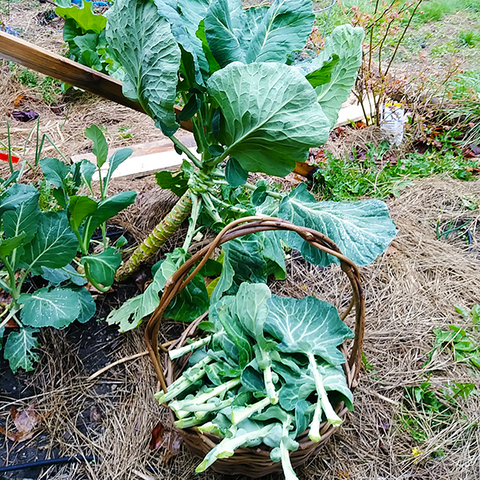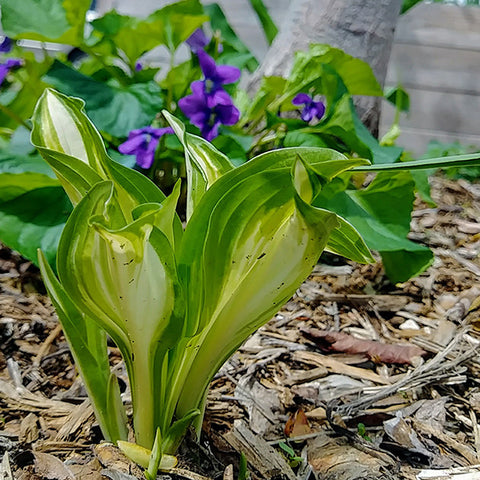
A perennial vegetable is an edible plant which, once established in your garden or food forest, will provide food for several (perhaps many) years to come. If you have seen my card game, you already know something about this subject. While perennial fruits are seemingly everywhere, perennial vegetables are harder to come by. Some of the best are hidden in plain sight, while others are virtually unknown.
When I first discovered perennial gardening, designing a collection of high-quality, perennial green vegetables for my temperate climate food forest (USDA Hardiness Zone 6b) was complex and confusing. Reference books were indiscriminate, with pages of marginally edible plants obscuring the few choice options. Many plants that seem obvious in hindsight were omitted completely. When I wanted to try a new plant, there were few sources available. Seeds were hard to find, and there were no instructions on germinating seeds, selecting locations, harvest and proper preparation.
So where do I find the best perennial vegetables? These days, more people grow perennial food crops, and a cottage industry of nurseries, seed distributors, and bloggers serves a growing number of perennial vegetable enthusiasts. You can often find seed and plant swaps at which you can pick up an unusual vegetable or two. Or, if you're in a rush, there's always Etsy and ebay. If you are shopping for information, a quick web search should locate articles on every one of the vegetables mentioned below.
So why should you grow perennial vegetables? The great thing about perennial vegetables is that, once they are started properly, many varieties will provide ample food in a limited space. This is also the challenge, since some of these plants can become too successful. If you don’t harvest them regularly, perennial vegetables may crowd out other plants.
 The benefits of perennial vegetable gardening may already seem obvious to you. However, some people have a difficult time even contemplating a no-till garden of vegetables that rises, unassisted, from the soil every spring. I won’t pretend that I have given up cucumbers, tomatoes, and squash. I have not. I also grow biennials, like lettuce, parsley, and Swiss chard. But my perennial vegetables give me food earlier, and more reliably, than any of the annual crops that I grow. And some of the plants that I used to struggle with, like broccoli and onions, have been replaced by perennial varieties that offer the same great flavor and texture with almost none of the effort.
The benefits of perennial vegetable gardening may already seem obvious to you. However, some people have a difficult time even contemplating a no-till garden of vegetables that rises, unassisted, from the soil every spring. I won’t pretend that I have given up cucumbers, tomatoes, and squash. I have not. I also grow biennials, like lettuce, parsley, and Swiss chard. But my perennial vegetables give me food earlier, and more reliably, than any of the annual crops that I grow. And some of the plants that I used to struggle with, like broccoli and onions, have been replaced by perennial varieties that offer the same great flavor and texture with almost none of the effort.
Over the past decade, I have pieced together a garden that relies heavily on perennial vegetables. Many are herbaceous. Some are familiar. Some are traditionally grown as annuals, and some have been classified as ornamental, even though they are food crops in other cultures. There are some that I intend to grow but haven’t had the opportunity to try. At this point in my gardening life, I am limited more by space and time than by options.
All of this is all to say that growing perennial vegetables is not just possible in a climate with four seasons, it is completely achievable and has been done by real human beings – even in climates as unforgiving as Northern New England!
If, in nature, over 90% of plants are perennials[i], why don’t we grow more  perennial vegetables? The answer is unclear, because most of our diverse selection of foods predates modern times. Maybe it was easier to domesticate annuals because their offspring could be selected on a yearly cycle[ii]. Perhaps this was also a defense strategy in more violent times, when land could be stolen but seeds were easy to pack and carry? Or maybe annual foods, many of which ripened in the fall, were easier to store over the winter? Whatever the reason, only 20% of our food crops are perennials, and 80% are planted repeatedly, year after year.
perennial vegetables? The answer is unclear, because most of our diverse selection of foods predates modern times. Maybe it was easier to domesticate annuals because their offspring could be selected on a yearly cycle[ii]. Perhaps this was also a defense strategy in more violent times, when land could be stolen but seeds were easy to pack and carry? Or maybe annual foods, many of which ripened in the fall, were easier to store over the winter? Whatever the reason, only 20% of our food crops are perennials, and 80% are planted repeatedly, year after year.
You may be wondering how good can perennial vegetables taste, and how hard are they to grow. We will take these two questions, each in turn.
First, how good do they taste? This question must be considered on a case by case basis. Some of these vegetables are best when blanched (grown under a pot). Some produce delicate broccoli-like clusters, and some grow florets with a spicy kick. Others look like spinach but have interesting flavors and textures. Some have a bitter flavor that I grew to love once my taste buds become accustomed to it. Some are familiar, like rhubarb and asparagus, and some are common but rarely eaten, like the humble, yet delicious hosta sprout and flower buds.
As for difficulty, the first year is often the hardest. Once you get through year 1, most perennial edibles are simple to grow and propagate, especially if they are properly suited to your hardiness zone. After year 2, you may have a hard time getting rid of them. Many of perennial food plants have vigorous roots. To remove the plant, you often need to remove the entire root – which is sometimes quite challenging.
 Now that you have a little background, it’s time for some examples. What kinds of perennial vegetables can you grow, and where do you find the seeds or seedlings? Below is a list of perennial vegetables that can grow in various hardiness zones. I have tailored this list to temperate growing regions. In warmer climates even tomatoes and peppers can be perennials, whereas temperate gardeners need to search a little harder to fill their perennial beds. Understanding that seed companies come and go, I advise you to simply google the plants, with the exception of one perennial kale, mentioned below the grid.
Now that you have a little background, it’s time for some examples. What kinds of perennial vegetables can you grow, and where do you find the seeds or seedlings? Below is a list of perennial vegetables that can grow in various hardiness zones. I have tailored this list to temperate growing regions. In warmer climates even tomatoes and peppers can be perennials, whereas temperate gardeners need to search a little harder to fill their perennial beds. Understanding that seed companies come and go, I advise you to simply google the plants, with the exception of one perennial kale, mentioned below the grid.
In this table, I provide examples of 21 perennial vegetables and 8 perennial herbs, along with USDA Hardiness zone recommendations for each. These Hardiness Zone recommendations are not universally agreed upon, and may be stretched (or limited) depending upon variety, breeding location, and micro-climates at your site. I tried to choose reputable sources of information but, if you want to see my source, I have provided a link to each article where USDA Hardiness Zone information was found.
A discussion of proper preparation and recipes is beyond the scope of this current article. I hope to cover more of that later. For the moment, please note that some portions of these plants are more edible than others, and many taste better at certain times of the year. For instance, only certain parts of the King Solomon's seal plant are safe to eat. Fortunately, information on how to prepare these vegetables is readily available on the internet. With proper research and attention to detail, each plant below can be served as a delicious side-vegetable or a handy addition to a larger recipe.
Sources
Most of the plants listed above are widely available with a quick search. Daubenton Kale, however, is only currently available in the US in a selection that was open-pollinated in the presence of purple tree collards, and sold by the Experimental Farm Network
If you have a favorite perennial vegetable, please share the information, and the hardiness zones, in the comments below.
Enjoy!
Karl
[i] Angelo Eliades, “Perennial Plants and Permaculture,” The Permaculture Research Institute (Permaculture Research Institute, June 3, 2016), https://www.permaculturenews.org/2012/06/06/perennial-plants-and-permaculture/.
[ii] American Journal of Botany. "Do long-lived crops differ from annual crops in their genetic response to human domestication?." ScienceDaily. ScienceDaily, 27 September 2011. www.sciencedaily.com/releases/2011/09/110927155224.htm.
